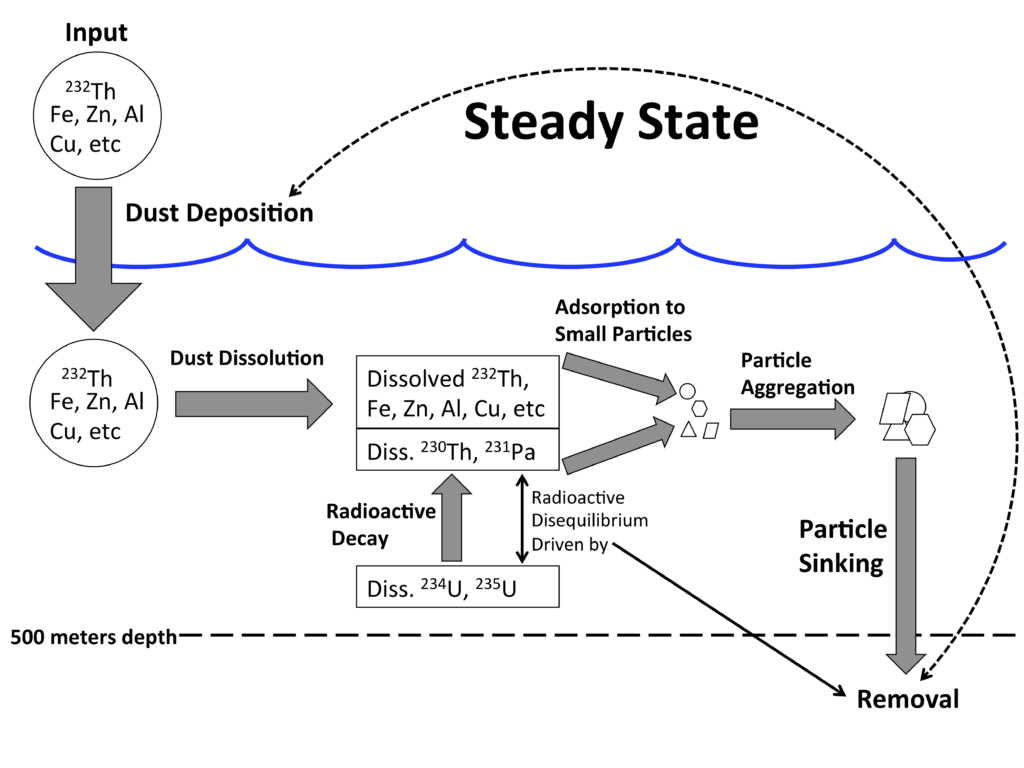Marine Biogeochemical Cycles
I seek to understand the input, output, and internal cycling rates of trace elements and carbon in the ocean. My research uses measurements of long-lived thorium and protactinium isotopes, which are uniformly produced in seawater by uranium decay. Upon production, these isotopes are rapidly removed via adsorption to settling particulate matter, thus providing a ‘clock’ through which the input and removal of other elements can be studied. A few of the specific chemical oceanography topics I study are below.
Hydrothermal scavenging
Hydrothermal vents emit metal-rich fluids into the deep ocean. These metals (e.g. Fe, Mn) react with seawater to form particulate (oxyhydr-)oxides with highly-reactive surfaces capable of adsorbing or co-precipitating other dissolved ions out of solution and carrying them to the seafloor. In Pavia et al. 2018 we found anomalous 230Th and 231Pa depletions in a hydrothermal plume extending 4000km downstream of he East Pacific Rise, attributed the removal to direct adsorption onto surface sites of metalliferous particles, and developed a model for the time evolution of 230Th and 231Pa in hydrothermal plumes. In Pavia et al. 2019 we included measurements of two other radiogenic Th isotopes (234Th and 228Th) with shorter half-lives to model the kinetics of hydrothermal scavenging. We were able to determine absolute or relative changes in rate constants for adsorption, desorption, and particle aggregation. We also found that much of the 230Th depletion observed off-axis must have occurred upstream as waters flowed northward along the EPR ridge axis towards our study side.

Dust deposition
In open-ocean regions far from rivers and continental shelves, the deposition of aerosol dust is a primary source of micronutrients like Fe to the sea surface. Dust-borne trace metals are limiting nutrients for primary productivity, N2-fixation, and other important biogeochemical processes at the sea surface.
Thorium isotopes are excellent tracers of dust input. Radiogenic 230Th is produced in the water column by uranium decay, while primordial 232Th is supplied to the ocean via the dissolution of lithogenic materials, like dust. Applying the in-situ residence derived computed from 230Th to 232Th allows for the determination of 232Th input rates, which can be converted to dust fluxes using the 232Th solubility and the Th concentration of dust.

I used these methods to determine dust input rates to the South Pacific Subtropical Gyre, an oceanic region modeled to have the lowest dust fluxes in the world. The iron fluxes from dust deposition are much lower than the theoretical lower limit needed to support observed rates of N2-fixation, instead requiring efficient microbial Fe recycling at the surface of the gyre (Pavia et al. 2020). Ongoing work is re-evaluating dust-borne Fe inputs in the Southern Ocean, and incorporating Th and Pa into global biogeochemical models to constrain dust inputs and Fe removal dynamics.
Particulate Carbon Cycling
I have worked to develop a method using 230Th/234U disequilibrium in marine particles as a “flux-gauge” to diagnose vertical particulate matter fluxes in the ocean interior. In essence, this method can be thought of as a chemical proxy for a sediment trap – but at much greater vertical and spatial resolution than could be achieved with trap deployments.
I used this method to study POC flux and regeneration in the Eastern Tropical South Pacific, using samples from the GEOTRACES GP16 section. POC regeneration length scales vary strongly between the highly productive waters overlying the Peru Oxygen Minimum Zone, and the oligotrophic waters of the South Pacific Gyre (Pavia et al. 2019). Work in progress on this topic includes studying the export and regeneration of other particulate constituents, including CaCO3 dissolution rates and mesopelagic iron residence times.